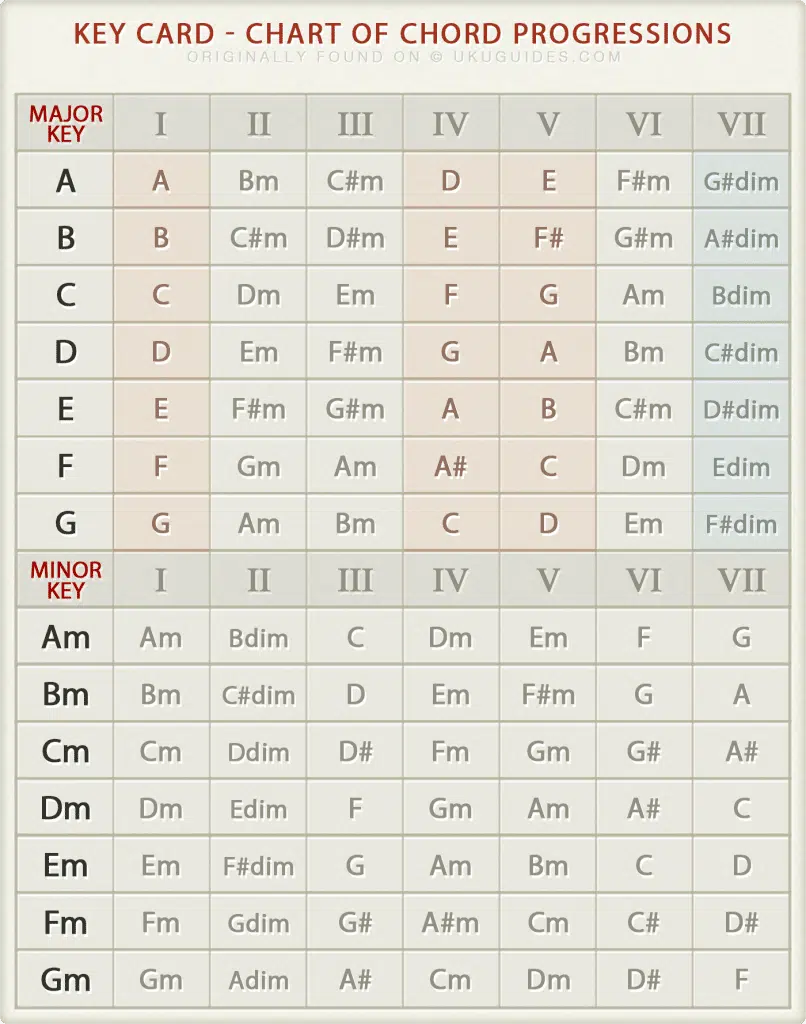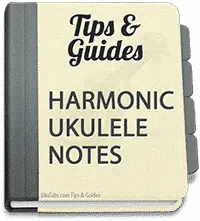To make a song sound good, you want the chords you use to match and sound good together. You can try a whole bunch of chords and see if they match, but there’s actually a quicker way to find matching chords, which is using ukulele keys.
Beware, this guide to “How to Write Songs” is not sacred. You can always improvise, “invent” new ukulele chords and much more. The main thing is to know what makes a song sound good.
First things first: what is a Ukulele key card?
What are these ukulele keys you are talking about?! Well, a key is basically a group of chords that sound “good” together. This is where the Key Card — for which you can find a downloadable PDF at the bottom of this page — comes in handy.

To find matching chords to create your song, you can simply choose a key from the card and use any of the chords on that line (horizontally). Then you need to create a strumming pattern and, last but not least, add the lyrics.
You can also start with the lyrics and find a matching key for them, of course. Note: use 6th, 7th or 9th versions of the chords to change the feel of your song.
Theoretically: how do you write songs using a ukulele key card?
If you take a close look at the key card, you will see that the I-IV-V chord progressions are highlighted on the card. These are the most common chord progressions in all the music that exists. This I-IV-V progression is called “figured bass” (or thoroughbass) by classical composers.
The “I-IV-V progression”, which is widely used in blues, rock, etc., basically states that the first chord you should play is the I chord, followed by the IV chord and finally the V chord. This combination of chords is bound to sound good together. An example is “Liquor Store Blues” by Bruno Mars, which is written in the E key since it has the chords C#m-G#m-A-B.
At the top you will find the “scale degrees”. Western scales have seven different degrees that are designated by the Roman numbers I to VII. A few examples of ukulele keys:
- Key of C -> Scale: C D E F G A B C
- A# -> Scale: A# C D D# F G A A#
- A -> Scale: A B C# D F F# G# A
Examples of the I-IV-V progression:
- Key of C -> C-F-G
- A# -> A#-D#-F
- A -> A-D-E
If you take a look at the major key, you can see it is divided into three “groups”. The triads for I-IV-V are all major chords. The triads for II-III-VI are all minor chords, and the triad for VII is a diminished chord. So, if you know the scales well, you can always find the IV and V. Simply play the major chord with that note as the root.
Key of G -> Major scale: G A B C D E F# G -> I-IV-V = G-C-D
Extras with this explanation of ukulele keys
Hopefully this guide has helped you to understand a bit better how chords are chosen to create songs. Feel free to download the ukulele keys guide PDF or separate key card PDF below.
The following additional tips were shared by an UkuGuides reader, thank you!
1. Count the chords in fourths
Looking at the Key Card you can also count the chords in fourths. I to IV is a fourth; IV to VII is a fourth; VII to III is a fourth, etc. The entire sequence in fourths is I – IV – vii – iii – vi – ii – V – I. (Lower case letters indicate minor chords). All common and popular chord progressions contain parts of this sequence of fourths. For example, the I – IV – V contains two fourths, one at the beginning, I – IV, and one at the end when you start over again, V – I.
2. The dominant 7th chord
The dominant 7th is the most important chord in a key. Each key only contains one dominant 7th, and it always leads to the I chord. It defines the key and drives the progression forward.
Because the dominant 7th leads to the I chord, it can be ‘borrowed’ from other ukulele keys as a way to lead into some other chord. For example, B7 does not belong to the key of G, but it can be used to lead to an Em because B7 is the V Chord (the dominant 7th) of the key of E:
- G – B7 – Em (in the key of G using a B7 to lead to Em)
Other examples:
- G – G7 – C (in the key of G using a G7 to lead to C)
- G – Am – A7 – D7 (in the key of G using an A7 to lead to D7)
Need more input about ukulele keys?
Feel free to contact me whenever you need more information about how to write ukulele songs using ukulele keys.
Also interested to know how to play harmonic notes on a ukulele?
